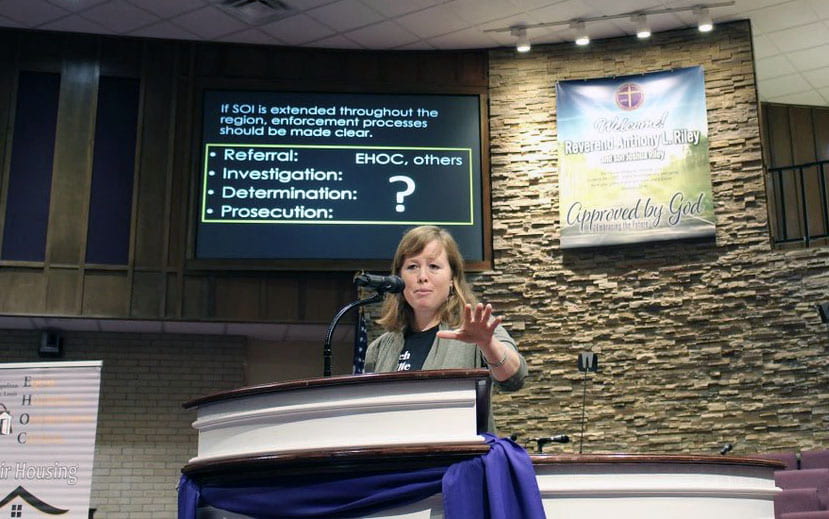True or false?
- Individual housing choices drive residential segregation.
- Solutions to segregation must involve the movement of low-income people of color.
- Segregation is only a problem for people living in areas of concentrated poverty.
Each is false, Molly Metzger said in her keynote address in April at the Metropolitan St. Louis Equal Housing and Opportunity Council’s annual Fair Housing Conference.
Metzger is an assistant professor at the Brown School and faculty director of Thriving Communities at the Center for Social Development. She discussed three fallacies about the causes of segregation during a speech called “Segregation: A threat to Americans’ shared goals.”
“The first fallacy is the idea that segregation is driven by individual housing choices,” she said. Redlining is not an abstract concept. “The Federal Housing Administration practiced it by literally drawing red lines around African-American neighborhoods” and supporting (or not supporting) mortgages based on race.
“The counterpart to that was greenlining of particularly white suburbs” to make mortgage products available in the suburbs, essentially subsidizing white flight in a way that left the central city underinvested, Metzger said.
The second fallacy is that solutions to segregation must involve the movement of low-income people and/or people of color. The actual solution is equitable investment, Metzger said. “When we’re using tax incentives, when we’re looking at investing in development, we need to make sure we are doing that equitably and intentionally and thinking regionally.”
‘Segregation is a problem for every single one of us’
The third fallacy is that segregation is only a problem for people who live in areas of concentrated poverty. “We know that there are stark health disparities by ZIP code, including major differences in life expectancy. We know that exposure to crime, availability of healthy foods, well-resourced schools, that these things are all distributed differently across space. But … segregation is a problem for every single one of us regardless of where we live,” Metzger said. Segregation affects economic growth, the democratic process and “whether or not we are living up to our espoused values as Americans.”
“More racially and economically integrated areas grow faster and in a more sustained pattern than places that are segregated.”
Watch excerpts of Metzger’s speech:
About 280 people attended the Fair Housing Conference, on April 12 at Central Baptist Church in St. Louis. Numerous panels focused on youth-centered strategies for community development, the future of inclusive housing, how to build wealth in areas of poverty, and equity indicators for housing and community development. Participants spent the afternoon in breakout sessions for in-depth discussions on housing topics.
The conference also highlighted the new book “Facing Segregation: Housing Policy Solutions for a Stronger Society,” edited by Metzger and Hank Webber. Webber is executive vice chancellor and chief administrative officer at Washington University in St. Louis. He is also professor of practice at the Brown School and the School of Architecture and Urban Design.
Webber closed the conference by challenging participants to contribute to making St. Louis a place where people live together in racially and economically diverse neighborhoods.
“Our tools for fighting segregation are much better than they were 50 years ago,” Webber said. “We understand how to do inclusionary zoning. We understand how to do community land trusts. We know how to enforce rules. …
“On the one hand, we’ve made a lot of progress. But there’s bad news, too. Despite knowing a lot more about segregation, knowledge that makes it very clear that segregation is wrong on every count, that it’s morally wrong, that it’s economically wrong and it’s unfair,” he said.
“The challenge is one of politics, and the challenge is one of mobilizing politics. … Politics is more important than policy. Because without good politics, you don’t have an opportunity to engage in good policy work.”
